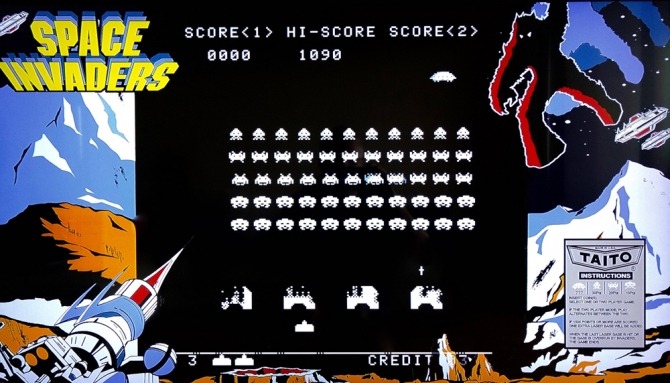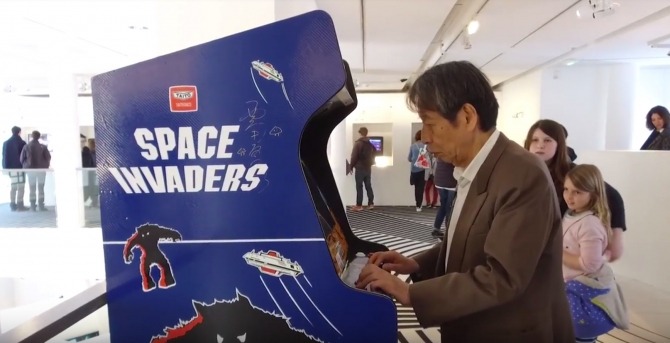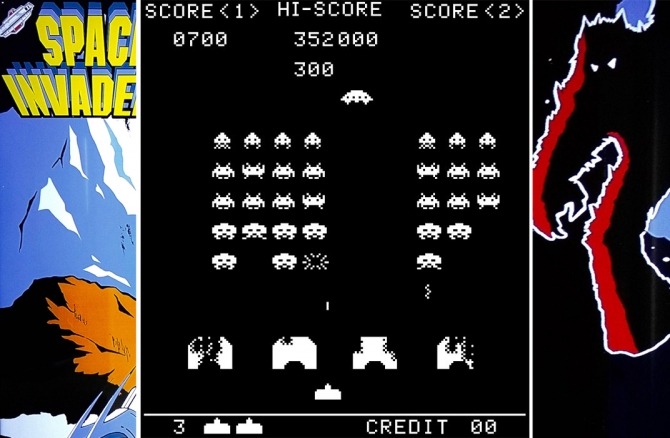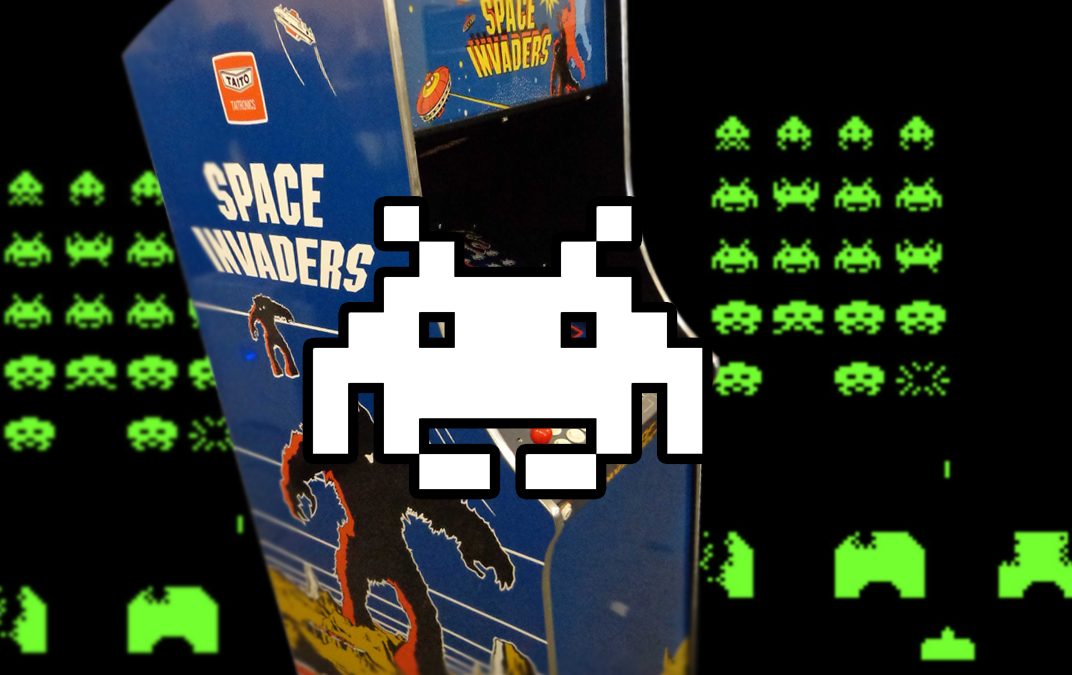The eerie thump-thump-thump of the aliens’ movements as they jerk back and forth along the screen. The basis that slowly crumble as they’re battered by laser blasts from both the aliens and the player. The siren call of the UFOS that occasionally streaked across the top of the play area, just begging to be shot down for bonus points.
Such are the sights and sounds of Space Invaders – not to mention the sensation of gnawing dread as those last few aliens gather speed – that the 1978 videogame has long since acquired classic status. The design of its aliens and the simple sound effects – all low murmurs and pew-pew lasers – are a part of our popular culture, while the game as a whole now has its own legends attached to it.
You may have heard how Space Invaders was so popular that it sparked a coin shortage in Japan, because players were throwing so much of their spare change into the machines. You may have read that its creator originally considered a military or wild west theme before he settled on invading aliens – partly thanks to the advent of popular sci-fi properties like Space Battleship Yamato and Star Wars.
What’s in danger of being overlooked, though, is just how brilliant the design of Space Invaders is – and how ingenious its creator was in building it.
To truly understand the genius of Space Invaders’ creator, Tomohiro Nishikado, consider another game he worked on earlier in the 1970s. It was called Sky Fighter II, and it was one of several mechanical games Nishikado made before Pong kicked off the early electronic videogame era.
Like Space Invaders, Sky Fighter II was a shooting game – albeit one that used relays and mechanics rather than integrated circuits and computer programs. Sky Fighter II tasked the player with shooting down a model aeroplane that circled around inside the cabinet; peering through a perspex window, it looked uncannily as though the craft was zooming through a cloudy sky, and if the player managed to strike the plane, it would explode dramatically.
In essence, it was a mix of mechanical ingenuity and conjuring trick, with mirrors and models used to created the illusion of a real plane puttering about in a 3D environment. The whole cabinet was so elaborate that it took months to design and several more to actually build. It was an early hint at what Nishikado, a former audio engineer, could do with relatively simple technology.
When Pong arrived on Japanese shores in 1972, the reaction to it at Taito, the amusement company where Nishikado worked, was rather mixed. Would the public really prefer this dull-looking machine, with its single monitor and dial on the front, to the mechanical games then popular in arcades? As it turned out, Pong was a big hit – simple bat-and-ball game that captured imaginations in both the east and west.
Nishikado quickly set his analytical mind to work on Pong. Back then, integrated circuits were an unfamiliar sight in Japan, and so, according to this super interview on Shmupulations, he spent the best part of six months examining and essentially reverse-engineering Pong’s hardware. Then, rather than using this information to simply create a rip-off of Atari’s pioneering game, he used it as a basis of his own: a two-paddled game called Soccer.
Soccer was Nishikado’s earliest foray into videogames, and paved the way for what would eventually become Space Invaders. Famously, Nishikado was partly inspired by Breakout: what if, he wondered, the blocks at the top of the screen moved and fired back at the player, and the player had to shoot them rather than hit them indirectly by deflecting a ball?

This, at least, provided the kernel of the Space Invaders concept. But before all that, Nishikado had to develop the game’s hardware from scratch; back then, there were no pre-built computers on which he could simply write the game’s code. Instead, he spent around six months selecting the microchips that would form Space Invaders’ custom hardware – then came a further four months of programming, as Nishikado created all the graphics, sounds and alien AI almost entirely by himself.
Originally titled Space Monster, the game was changed to Space Invader and then Space Invaders at the behest of Nishikado’s superiors – many of whom were nonplussed by what he’d created. While some staff members within Taito enjoyed Space Invaders, the general fear among bosses and amusement arcade owners was that it was simply too difficult; with the aliens shooting back at the player and the game ending when the invaders reached the bottom of the screen, the assumption was that its steep learning curve would prove too off-putting.
What nobody could have reckoned on – even Nishikado, seemingly – was that players would devise their own strategies for improving their chances in Space Invaders, and even studied the game for exploits in its programming. Nishikado hadn’t, for example, reckoned on players discovering that the UFO – which provided precious bonus points – was triggered by how many shots the player fired. Once players figured this out, the pattern became predictable – making the UFO’s appearance relatively simple to anticipate. Nor had Nishikado predicted that players would exploit a bug where the bottom row of invaders wouldn’t fire at the player if they were directly above his or her ship.

“One day,” Nishikado later said, “I saw a really good player putting up some high scores around 150k. When I looked closely at what he was doing, I saw that the very bottom row of invaders’ shots seemed to pass right through his ship. It’s because I programmed it so that their shots would come out just a little bit in front of the invaders.”
Ironically, it was this layer of strategy that helped Space Invaders become such a phenomenon. Earlier arcade games, like Pong and Breakout, were entertaining for a few minutes or so, but they were somewhat lacking in features that could be used to the player’s advantage. The ability to take out aliens in rows or columns, to anticipate the arrival of the bonus UFO, as well as the gradual increase in speed as the invaders’ ranks diminished (another quirk of Nishikado’s meagre hardware) turned a simple shooter into a game that rewarded practice and repeated play. And with that came enormous profits for the company behind it, Taito.
Following a slow start in 1978, Space Invaders began to proliferate all over the world, particularly in Japan, where entire amusement centres were opened purely to house row after row of cabinets. In the wake of Space Invaders, rival companies clamoured to either produce their own direct clones or similar shooters that riffed on its ideas. Indeed, it’s remarkable to see how rapidly arcade games evolved in the late 70s and early 80s, from the monochrome screen of Space Invaders, via the full-colour sprites of Namco’s Galaxian and Galaga.

Space Invaders was far from the first arcade game, but it was undoubtedly the catalyst for what would become a golden age of videogaming. Without it, we may never have had such hits as Pac-Man or Donkey Kong. More fundamentally, the Japanese videogame industry may not have started quite so early, or flourished quite so vibrantly. Although Nishikado continued to work in videogames for years after Space Invaders, he never had the chance to be quite so hands-on with a game’s design and development; like so many Japanese creators of his generation, he was forced to live in relative quiet while his game captured the zeitgeist.
Forty years ago, Space Invaders emerged in a flash of design and programming ingenuity. That it was such a phenomenon was partly due to timing – it landed just as Star Wars mania was gripping the planet – but even so, its brilliance shouldn’t be underestimated. Even today, with our vastly complex sandbox games and HD graphics, Space Invaders holds a certain allure: it’s easy to see at a glance what the objective is; its pendulum-like rhythm, gradually building in pace as the aliens wink out of existence, is mesmeric.
The original cabinets that housed Space Invaders are dwindling in number, their chipboard carcasses crumbling, the components inside requiring ever more care to protect them against the ravages of time. Even so, Space Invaders remains immortal somehow; captured forever on mobile phones, consoles and platforms like Steam; its iconic alien sprites printed on t-shirts, its sounds echoing in the minds of a generation of gamers.

